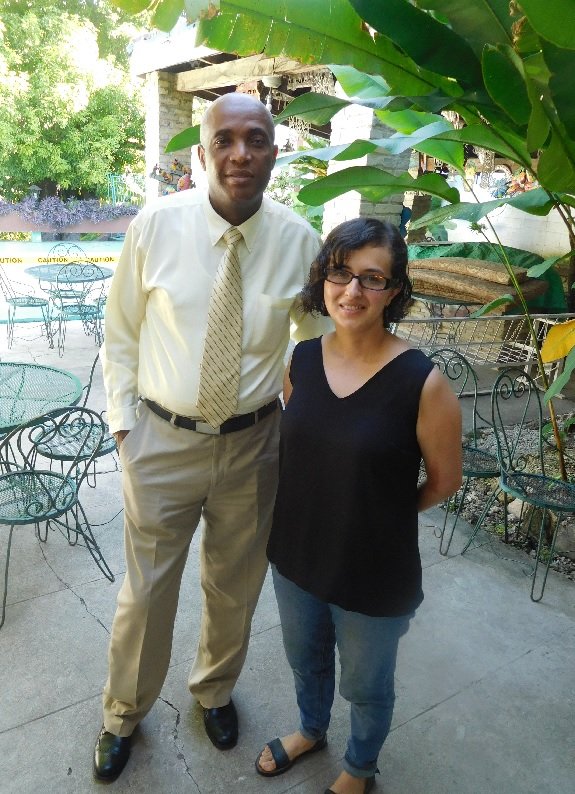2020…a year of remembrance
20 January 2020
20 January 2020
 Revd Chrisnel Lelievre (pictured with partnership coordinator for Latin America and the Caribbean, Sandra Lopez) is the Vice President of the Haiti District and a former Scholarship and Leadership Training programme bursar. Thanks to the World Mission Fund, he received a scholarship to do a PhD in at Queen’s College in Birmingham, after which he returned to Haiti to serve his church. He shares his thoughts with us on the 10 years since the earthquake in Haiti:
Revd Chrisnel Lelievre (pictured with partnership coordinator for Latin America and the Caribbean, Sandra Lopez) is the Vice President of the Haiti District and a former Scholarship and Leadership Training programme bursar. Thanks to the World Mission Fund, he received a scholarship to do a PhD in at Queen’s College in Birmingham, after which he returned to Haiti to serve his church. He shares his thoughts with us on the 10 years since the earthquake in Haiti:
“It has already been 10 years since a violent earthquake devastated our country Haiti, notably Port-au-Prince, the capital. More than 250,000 people were killed and thousands of private and public residences destroyed. All of the country's infrastructure had been affected and damaged.
This year 2020, marking the anniversary of this monstrous event, is a year of remembrance. The people could never forget it. Several activities and events are organized in memory of all the victims during which the victims’ relatives and friends, the survivors tell their story of this unforgiving disaster. Some of them say that the effects and after-effects are still present in their minds and memories. In fact, what has been in the country for the past ten (10) years, i.e. from January 12, 2010 to January 12, 2020?
We can divide the interventions carried out into two main groups:
1) Structuring interventions:
Several structuring interventions were implemented after the earthquake of January 12, 2010. These interventions were primarily aimed at preventing loss of life and irreparable material damaged like those recorded during the earthquake of January 12, 2010. The most significant of these interventions were:
a. Development of a Building Code. In fact, two building codes were developed by the authorities after the earthquake:
b. A first prepared by the Ministry of Public Health and the Ministry of Public Works, Transport and Communications with funding from the World Bank. This first document put a lot of emphasis on the resilience of health infrastructure and public buildings.
c. A 2nd building code prepared by the Ministry of Public Works, Transport and Communications, which embraced all types of buildings
d. Training / training of building technicians on norms and standards for earthquake-resistant construction. Several hundred building professionals and technicians have been trained in the 10 geographic departments of the country. (Engineers, foremen, masons, etc.).
e. Development of a mapping of seismic risk zones across the country.
f. Awareness campaign on the resilience of buildings and the need to respect resilience standards when constructing houses. Simulation sessions are carried out in areas at high risk of earthquakes.
2) Non-structuring interventions.
In addition to these structuring interventions, several interventions aimed at repairing the damage caused by the earthquake have been implemented. Here, succinctly summarized the main interventions worthy of attention:
a. Construction of temporary shelters for displaced populations. Several tens of thousands of people have benefited from housing in temporary buildings in recent years.
b. Repair or reconstruction of the majority of healthcare infrastructures destroyed or damaged by the earthquake. (Hospitals and health centres)
c. Reconstruction of several other public buildings: churches, schools, administrative buildings, etc. These constructions and repairs were carried out thanks to the huge solidarity movement that followed the first months of the earthquake. (Multilateral and bilateral cooperation, international NGOs, churches, Christian missions, etc.) Several temples and Methodist schools destroyed by the earthquake were rebuilt thanks to the partnership of sister missions such as the Methodist Church of Britain.
3) What remains to be done:
Despite these achievements, much remains to be done.
a. The building code in force is not widely known, even less systematically applied. So that non-resilient constructions continue to be erected all over the country.
b. Several public buildings, churches, schools, administrative buildings (including the national palace), still operate today in temporary buildings.
c. Several spontaneous neighbourhoods that arose out of nowhere after the earthquake and operating in total disregard of planning standards constitute serious dangers for those who live there.
d. The Cholera crisis, an indirect consequence of the earthquake, is largely under control. However, the risk of resurgence this deadly disease is still present due to the poor hygienic conditions prevalent in the population, the poor quality of drinking water and the poor protection of food.
So far, people have been living in temporary shelters. Despite efforts to repair the damage, there are still rubble and remains. Church, school, shop, office buildings are still in ruins.
Certain private and public institutions receiving aid from friendly countries are highly criticized for having mismanaged the funds received and achieved so little during the past ten years. Much more could be done to help the survivors and rebuild the nation.
4) Conclusion
Today, the lives of citizens are becoming more and more difficult. They put their hope in God and in God alone so that they get out of this chaotic and chronic situation. In addition, there is the socio-political and economic crisis which shakes, without distinction, all the social classes of the country.
A collective awareness against the bad policies put in place to destroy people's lives and property is necessary and essential. This tragic event experienced by the Haitian people should be a first and a last one that will never happen. Because the principles and standards established to carry out the country will be rigorously and scrupulously respected for everyone. That’s our hope.”